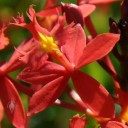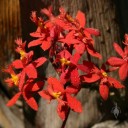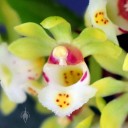Domingoa
Posted September 13th, 2013 by Marc CohenCategories: Dormancy, Growing, Intermediate Growers, Mini Orchids, Photos, Watering
Considering its tiny flowers, this unusual Domingoa can really put on a show. Its thick, speckled leaves produce long stems with tiny purple blossoms. This plant can stay in bloom for more than two months, putting out successive flowers over late summer and early autumn.
I’ve had this Domingoa growing outdoors and blooming well for three years, but the flowers are so small that it’s been tough to take nice photos. Dave took some great shots recently, so I can finally share this little gem. Each flower is about 1/4 inch (6 mm) wide. Small bunches swing at the ends of spikes, or flower stems, which can grow over 1 foot (30 cm) long. The wiry spikes may look dead after blooms finish, but they can rebloom for years.
White and red speckles on the thick leaves keep this orchid interesting, even when it’s not flowering. Here on the California coast, it grows outdoors on a mount in partial sun. I keep it well-watered until winter dormancy, when I bring it indoors and cut back watering. It stays in our back room, where winter nighttime temps go down to 50°F (10°C,) until spring.
Native to parts of Mexico and Central America, this species recently underwent a name change from Nageliella to Domingoa. It’s an uncommon orchid to find, and it’s often listed under its old name. No matter what it’s called, it’s easy to find space for this charming mini in any collection.



































